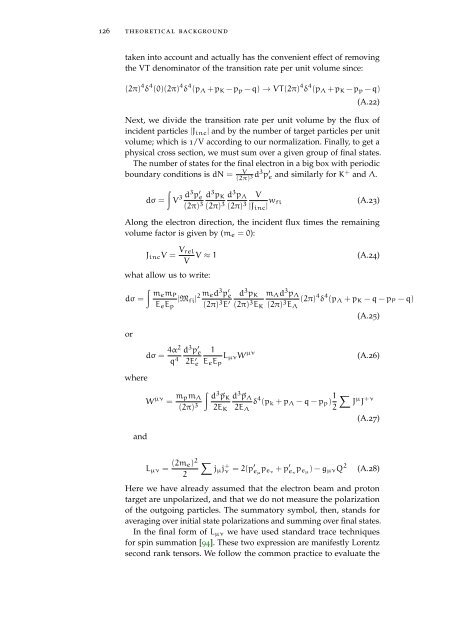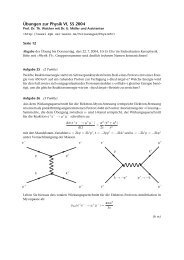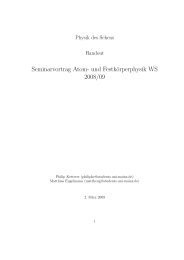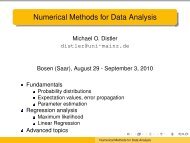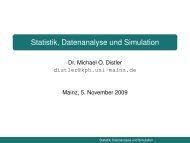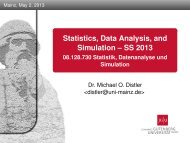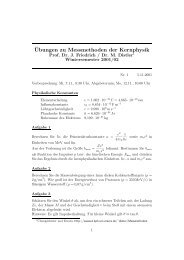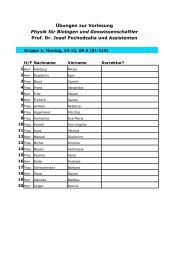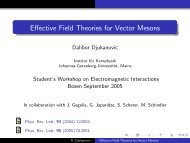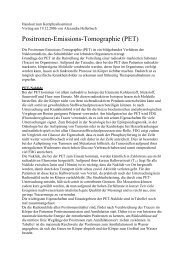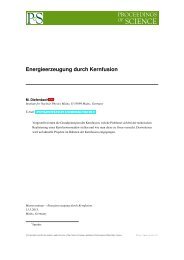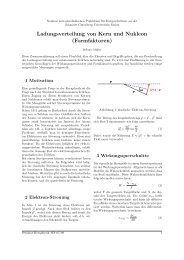A Classic Thesis Style - Johannes Gutenberg-Universität Mainz
A Classic Thesis Style - Johannes Gutenberg-Universität Mainz
A Classic Thesis Style - Johannes Gutenberg-Universität Mainz
You also want an ePaper? Increase the reach of your titles
YUMPU automatically turns print PDFs into web optimized ePapers that Google loves.
126 theoretical background<br />
taken into account and actually has the convenient effect of removing<br />
the VT denominator of the transition rate per unit volume since:<br />
(2π) 4 δ 4 (0)(2π) 4 δ 4 (pΛ + pK − pp − q) → VT(2π) 4 δ 4 (pΛ + pK − pp − q)<br />
(A.22)<br />
Next, we divide the transition rate per unit volume by the flux of<br />
incident particles |Jinc| and by the number of target particles per unit<br />
volume; which is 1/V according to our normalization. Finally, to get a<br />
physical cross section, we must sum over a given group of final states.<br />
The number of states for the final electron in a big box with periodic<br />
boundary conditions is dN = V<br />
(2π) 3 d 3 p ′ e and similarly for K + and Λ.<br />
�<br />
dσ =<br />
V 3 d3p ′ e<br />
(2π) 3<br />
d3pK (2π) 3<br />
d3pΛ (2π) 3<br />
V<br />
|Jinc| wfi<br />
(A.23)<br />
Along the electron direction, the incident flux times the remaining<br />
volume factor is given by (me = 0):<br />
JincV = Vrel<br />
V ≈ 1 (A.24)<br />
V<br />
what allow us to write:<br />
dσ =<br />
or<br />
where<br />
and<br />
� memP<br />
EeEp<br />
dσ = 4α2<br />
q 4<br />
|Mfi| 2 med 3 p ′ e<br />
(2π) 3 E ′<br />
d 3 p ′ e<br />
2E ′ e<br />
W µν = mpmΛ<br />
(2π) 3<br />
Lµν =<br />
(2me) 2<br />
2<br />
1<br />
d3pK (2π) 3EK LµνW<br />
EeEp<br />
µν<br />
mΛd3pΛ (2π) 3 (2π)<br />
EΛ<br />
4 δ 4 (pΛ + pK − q − pP − q)<br />
(A.25)<br />
(A.26)<br />
�<br />
d3�pK d<br />
2EK<br />
3�pΛ δ<br />
2EΛ<br />
4 (pk + pΛ − q − pp) 1 �<br />
µ +ν<br />
J J<br />
2<br />
(A.27)<br />
�<br />
jµj + ν = 2(p ′ eµ peν + p′ 2<br />
eνpeµ ) − gµνQ<br />
(A.28)<br />
Here we have already assumed that the electron beam and proton<br />
target are unpolarized, and that we do not measure the polarization<br />
of the outgoing particles. The summatory symbol, then, stands for<br />
averaging over initial state polarizations and summing over final states.<br />
In the final form of Lµν we have used standard trace techniques<br />
for spin summation [94]. These two expression are manifestly Lorentz<br />
second rank tensors. We follow the common practice to evaluate the


